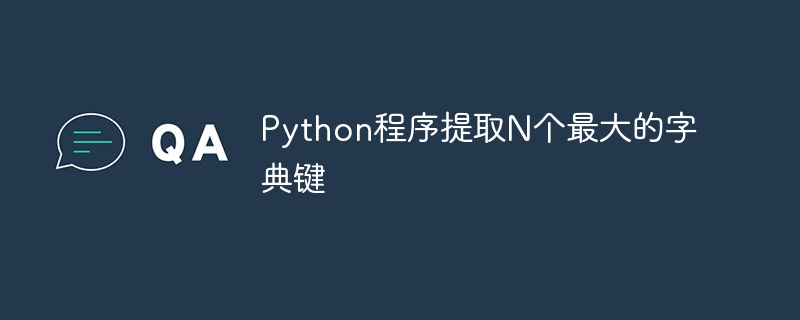

A Python dictionary is a data structure that can be used for a variety of operations, making it a prolific programming tool. It stores data in the form of key-value pairs, i.e. each data can be tagged with a unique key. Keys in a dictionary are identifiers associated with different values that can be accessed, modified, and deleted.
Keys can be sorted and extracted in different orders depending on the task. In this article, we will discuss the similar concept of extracting N maximum dictionary keys. We will operate on these unique keys and extract the relevant data.
Consider a dictionary with random unique key values, our task is to separate the largest N keys from the dictionary. Let us understand this through an example -
Let us consider a dictionary with the following values -
Input:
dict1 = {12 : 10, 22 : 12, 18 : 4, 4 : 8, 20 : 14, 9 : 13}
If the value of N is 4, return the four largest key values in the original dictionary.
Output: [22, 20, 18, 12]
Return at most N key values. Now that we understand the problem statement, let's discuss some solutions.
This is the basic way to extract the N largest keys from a dictionary. We will create a dictionary and two empty lists to store the maximum value and the reference value respectively. After that, we will pass the "N" value and extract the key value with the help of iteration and ".items()" method.
These extracted values will be stored in a list (Maxlis). We will iterate over the appended dictionary keys "N" times again and extract all the maximum values. On each iteration, the largest key value is removed from the list and the list with the largest N keys (Nlargest) is printed.
The following is an example of extracting the N largest dictionary keys using iteration and appending -
dict1 = {12 : 10, 22 : 12, 18 : 4, 4 : 8, 20 : 14, 9 : 13}
Maxlis = []
N = 4
Nlargest = []
print(f"The original dictionary is: {dict1}")
for keys, values in dict1.items():
Maxlis.append(keys)
for x in range(N):
maxval = max(Maxlis)
Nlargest.append(maxval)
Maxlis.remove(maxval)
print(f"The list of N largest dictionaries keys: {Nlargest}")
The original dictionary is: {12: 10, 22: 12, 18: 4, 4: 8, 20: 14, 9: 13}
The list of N largest dictionaries keys: [22, 20, 18, 12]
This is an advanced method of extracting the N largest keys. In this method we will retrieve all dictionary keys using iteration and ".items()" method. We will use the "key" parameter in the "sorted()" function to specify another function (lambda) to handle the extraction logic. The lambda function extracts the keys and the sorted() function sorts them in order.
The "reverse = True" clause sorts the key values in descending order. Finally, we use slicing technique to extract only the first N keys from the dictionary and store them in a list (Nlargest).
The following is an example -
dict1 = {12 : 10, 22 : 12, 18 : 4, 4 : 8, 20 : 14, 9 : 13}
N = 4
Nlargest = []
print(f"The original dictionary is: {dict1}")
for keys, values in sorted(dict1.items(), key = lambda item : item[0],
reverse = True) [:N]:
Nlargest.append(keys)
print(f"The N largest keys are: {Nlargest}")
The original dictionary is: {12: 10, 22: 12, 18: 4, 4: 8, 20: 14, 9: 13}
The N largest keys are: [22, 20, 18, 12]
Instead of using the lambda function, we can use the "itemgetter()" function in the operator module to extract items. We will use the same concept of iteration and sorting keys, but the "key" parameter will be assigned the "itemgetter()" function to extract the key.
The following is an example -
from operator import itemgetter
dict1 = {12 : 10, 22 : 12, 18 : 4, 4 : 8, 20 : 14, 9 : 13}
N = 4
Nlargest = []
print(f"The original dictionary is: {dict1}")
for keys, values in sorted(dict1.items(), key = itemgetter(0),
reverse = True) [:N]:
Nlargest.append(keys)
print(f"The N largest keys are: {Nlargest}")
The original dictionary is: {12: 10, 22: 12, 18: 4, 4: 8, 20: 14, 9: 13}
The N largest keys are: [22, 20, 18, 12]
There are various techniques for extracting the largest N keys from a dictionary, including using the "nlargest()" function in the "heapq" module and function-based sorting . Setting the correct values for the "lambda" and "itemgetter" functions is very important as it sets the stage for item sorting and extraction.
In this article, we discussed various solutions for extracting the N largest dictionary values. We start with a basic and crude approach of isolating and attaching the largest key. Afterwards, we discuss some advanced solutions to generate detailed and optimized programs. We learned about the applications of sorted(), lambda, itemgetter, and max() functions.
The above is the detailed content of Python program to extract N largest dictionary keys. For more information, please follow other related articles on the PHP Chinese website!




